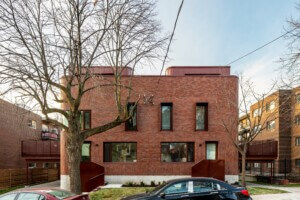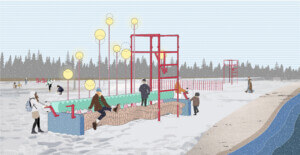Competition winner uses composite materials to re-imagine Semper’s primitive hut.
The title of TEX-FAB‘s fourth annual competition—Plasticity—has a double meaning. It refers first to the concept at the core of the competition brief: the capacity of parametric design and digital fabrication to manifest new formal possibilities. But it also alludes to the material itself, fiber-reinforced polymer (FRP). “Plastics have the potential to push contemporary architecture beyond the frame-plus-cladding formula dominant since at least the 19th century,” said competition winner Justin Diles. Pointing to traditional stonecutting and vault work, he said, “I’m very interested in this large volumetric mode of construction, but I’m not at all interested in the stone. I think that composites probably offer the best way of addressing this old yet new mode of constructing architecture.”
Diles’ proposal, Plastic Stereotomy, builds on his work as a KSA fellow at The Ohio State University. But where his earlier Eigenforms were two-dimensional freestanding walls, Diles’ Plastic Stereotomy pavilion—which he will build at scale during the coming months—is fully three-dimensional. Inspired by teaching tools designed by Robert le Ricolais, Diles used a finite element analysis 3D modeling plugin to simulate surface buckling by superimposing volumes onto one another. “Those pieces are voluptuous; they create a lot of poché [thickness] as they overlap with one another,” Diles observed. While the plugin developed by his friend was critical to the design process, Diles remained focused throughout on the end goal of fabrication. “What I’m really looking at is how we can use simulation to think about issues of construction rather than just optimization,” he said.
Custom fabrication shop Kreysler & Associates will provide technical support as Diles moves from design to construction. Diles cites the fire-resistant FRP cladding developed by Kreysler for Snøhetta‘s SFMOMA as an example of how composite materials can ease the transition from two-dimensional to volumetric design. “Even though the project still adheres to Gottfried Semper’s model of a lightweight frame and cladding, the panels don’t have a frame expression,” he said. “They’re massive, with ripples and indentations. They point to a new way of thinking about architectural surface and enclosure.”
- Fabricator
Justin Diles - Designers
Justin Diles - Location
Los Angeles, CA and Houston, TX - Date of Completion
2014 (prototype), 2015 (full-scale pavilion) - Material
FRP, paint, glue, bolts, solid foam blocks - Process
3D modeling, FEM, CNC milling, molding, painting, glueing, bolting
Kreysler and Diles will work together to streamline the techniques he used to build his competition prototype, a scaled-down section of the Plastic Stereotomy pavilion. (Bollinger + Grohmann will provide additional structural and material engineering support.) For the mockup, Diles used a 5-axis CNC mill to shape EPS foam molds onto which he layered up FRP cloth. He then removed the pieces from the molds, painted them, and glued and bolted them together, adding stiffeners to the open-backed components. Because the FRP is so light, he used two solid foam blocks to weigh down the structure. “I’m interested in working with Kreysler around thinking through production to make it more efficient,” said Diles.
For the fabricators, the TEX-FAB collaboration represents another step in Kreysler’s journey from boat-building to other applications of composite materials, including architecture. “We’re excited to work on this with Justin,” said Kreysler’s Josh Zabel. “It’s exciting to see designers put fresh eyes on these materials we’re devoted to.”
Plastic Stereotomy will be on display at TEX-FAB 2015 Houston at the University of Houston College of Architecture, March 26-29. The conference will feature workshops, lectures, and an exhibition on the theme of Plasticity.










